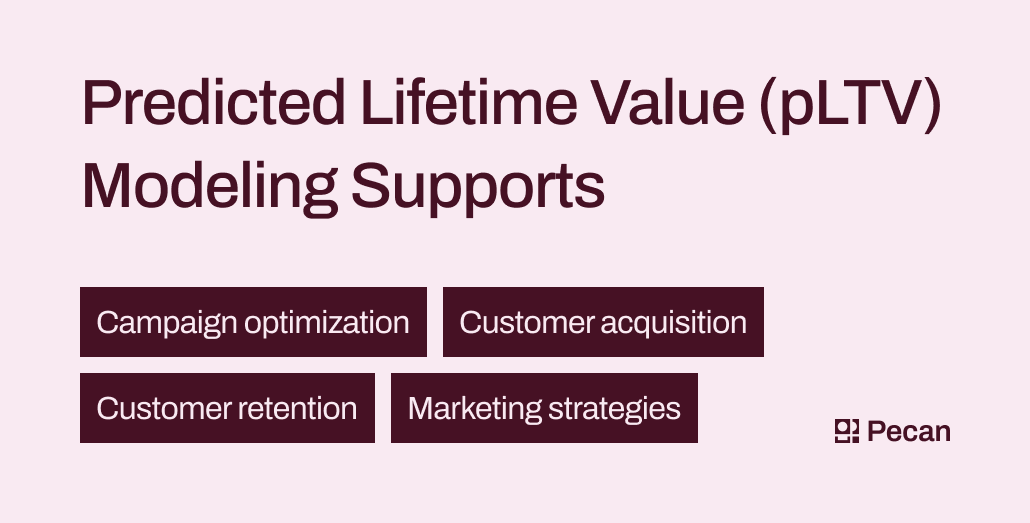In a nutshell:
- Predicted Lifetime Value (pLTV) helps estimate the potential value of a customer over their lifetime.
- pLTV is essential for identifying high-value users, tailoring marketing strategies, and allocating budgets effectively.
- pLTV is especially useful today due to privacy regulations and limited access to user-level data.
- Predicted Lifetime Value modeling with machine learning offers more accurate predictions by considering real-time data and dynamic factors.
- pLTV can shape marketing campaigns by enabling personalized marketing and effective customer retention strategies.
A year from now, you'll look back at reading this blog post and think, Wow, I'm sure glad I looked up "pltv" that day.
Actually, you'll probably have that thought even sooner because using machine learning to foresee predicted lifetime value (pLTV) for your customers can have a much faster — and larger — impact on your business than you probably realize.
Right now, though, many marketers and CX pros are diving into pLTV for the first time. They're learning more about this cutting-edge approach to understanding their customers' or users' long-term behavior — in advance.
This blog post will guide you through the meaning of Predicted Lifetime Value and how it differs from the traditional LTV calculations you might know from the past. We'll also look at the many ways pLTV predictions can be used in various businesses, including for marketing and customer retention. And if that's all sounding good, we'll give you a roadmap for your next steps.
Keep reading — this blog post has high pLTV for you (get it?).
-

- Photo by rupixen.com on Unsplash
What is predicted lifetime value (pLTV)?
Predicted Lifetime Value (pLTV) is a metric that helps businesses estimate the potential value of a customer over their entire relationship with the business. pLTV uses machine learning and anonymized data to estimate the average revenue a customer or user will generate over their lifetime.
By analyzing customer behavior and historical data, companies can predict how much revenue a customer will likely generate in the future.
This information is valuable for making informed decisions about business needs, including campaign optimization, customer acquisition, retention, and marketing strategies. This technique also provides insights into overall marketing performance, revealing how effectively marketing efforts draw high-value users or customers.
-

- How predictive lifetime value (pLTV) modeling can help your business
A note: Predicted Lifetime Value can be used in a variety of industries, including e-commerce, retail, insurance, mobile apps and games, and more. We'll refer to both "customer" and "user" pLTV here interchangeably.
Why is pLTV important?
pLTV benefits marketers in a variety of ways. Here are some examples:
- Identify which acquisition source brings in higher-value users.
- Reveal specific behaviors and activities related to users' Predicted Lifetime Value, then tailor marketing strategies accordingly.
- Forecast revenue over a longer period and allocate budget to the marketing channels most likely to attract the highest-spending users.
By leveraging the power of data-driven segmentation, pLTV empowers marketers to maximize their marketing performance and achieve meaningful revenue growth.
"When it comes to driving profitable growth in the long term, customer lifetime value (CLV) is a metric that can no longer be ignored," say marketing measurement experts Neil Hoyne, Chief Measurement Evangelist at Google, and Peter Fader, Professor of Marketing at the Wharton School of the University of Pennsylvania.
Why is Predicted Lifetime Value especially useful today?
pLTV has become especially valuable today because user-level data has become less and less accessible to marketers.
The introduction of privacy regulations like Apple's App Tracking Transparency (ATT) has posed challenges for businesses in calculating customer lifetime value (LTV) with user-level data. With ATT, users can opt out of being tracked by apps, limiting the availability of user-level data for analysis.
The introduction of SKAdNetwork (SKAN) further complicates the calculation of LTVs. SKAN limits the amount of data that can be shared between advertisers and app developers, making it even more challenging to gather user-level data for accurate LTV calculations.
That's where Predicted Lifetime Value comes in. To address this issue, businesses turn to predicted lifetime value (pLTV) as an alternative approach.
pLTV uses machine learning methods drawn from AI with anonymized data to estimate lifetime values while respecting user privacy.
By leveraging predictive models and aggregated data, businesses can still estimate the potential value of their customers without relying on individual user-level data. Predicting users' LTV respects privacy restrictions, but makes the most of available data.
-

- Photo by freestocks on Unsplash
How does pLTV differ from traditional LTV calculations?
Predicting LTV is the cutting-edge way to use today's artificial intelligence technology to anticipate customer lifetime value (LTV). It's a cutting-edge way to anticipate customer lifetime value (LTV) and offers several advantages over traditional LTV calculations.
Traditional LTV models rely on historical campaign data and assumptions to estimate the value a customer will bring to a business over their lifetime. This approach has limitations as it assumes that the future behavior of customers will be similar to their past behavior. However, customer behaviors and preferences can change over time, making it challenging to predict their future value accurately.
On the other hand, pLTV uses advanced predictive analytics techniques to forecast the potential value of a customer based on their current characteristics, behaviors, and market trends. By leveraging up-to-date information and considering dynamic factors, Predicted Lifetime Value models predict a customer's lifetime value more precisely.
An example of pLTV vs. traditional LTV
Consider an e-commerce business that wants to calculate the LTV of a new customer. Using a traditional LTV model, the company would have to rely on historical data such as past purchase behavior, average order value (AOV), and customer retention rate to estimate the customer's future value. However, this approach may overlook important factors such as changes in customer preferences, market trends, or an upcoming promotion that might influence the customer's purchasing behavior.
In contrast, with Predicted Lifetime Value, the e-commerce business can analyze the customer's recent browsing behavior, engagement with personalized marketing campaigns, and external factors like seasonality or competitor activities. By incorporating these dynamic factors and using predictive analytics algorithms, the business can more accurately predict the customer's future value. Those accurate predictions can guide more informed, better decisions regarding customer acquisition, retention, and personalized marketing strategies.
It's just a matter of keeping current with the latest, most effective methods. pLTV offers a more precise and dynamic approach to estimating customer lifetime value compared to traditional LTV models.
With the help of their data and predictive analytics, businesses can gain valuable insights into customer behavior and make data-driven decisions to maximize customers' lifetime value.
-

- Photo by Heidi Fin on Unsplash
What data is needed for pLTV predictive modeling?
To obtain valid, actionable insights, it's crucial to build an accurate pLTV model and continuously update it with relevant data. This approach involves collecting good-quality data that's essential for predictive analysis of lifetime value.
To build an accurate Predicted Lifetime Value model, businesses must collect relevant, rich statistical information, including data points such as customer demographics, purchase history, and engagement metrics. By continuously feeding this data into a prediction model, businesses can refine their pLTV estimates. Fortunately, most companies are already collecting these data points routinely, though they may not be using them for predictions just yet.
With reliable data collection methods and regularly auditing and validating data, businesses can improve the accuracy of their pLTV calculations.
How can pLTV shape marketing campaigns and decisions?
Personalized marketing with pLTV
pLTV can be used to create personalized marketing campaigns tailored to individual predicted lifetime values. By analyzing customer data and predicting their future value, marketers can segment their customer base and create targeted campaigns more likely to resonate with each customer and their likely level of future engagement. Here's what that could look like:
- A company that sells fitness equipment may use Predicted Lifetime Value to identify customers likely to purchase additional products in the future. They can then create personalized campaigns for these customers, offering discounts on related products or sending them targeted content that aligns with their interests.
- An online streaming service could use pLTV to identify paying subscribers most likely to have a high lifetime value. They can then create personalized campaigns for these customers, offering them special upgrades or VIP promotions.
These optimized marketing efforts provide a more personalized experience for their customers, leading to increased customer loyalty and revenue.
Shaping customer retention strategies with pLTV
pLTV can be a valuable tool for businesses to create effective strategies for retaining customers. By understanding the projected lifetime value of their customers, companies can allocate resources and implement strategies that focus on keeping their most valuable clientele. Get inspired with these examples:
- A cosmetic subscription box service could use Predicted Lifetime Value to foresee customers' future potential, providing individual insights into which customers might upgrade — or discontinue their subscription level. By proactively targeting these customers with personalized incentives or offers, the business can enhance the chances of retaining them and prolonging their value over time. At the same time, they also conserve resources by not offering discounts or bonuses to lower-value customers.
- A retail store could use pLTV to identify customers who have the potential to become high-value shoppers. The store could foster customer loyalty and drive long-term value by nurturing these shoppers through personalized email messages or direct mail, exclusive incentives, or special access to limited-edition items.
- An insurance company could leverage pLTV to segment customers based on their projected lifetime value. By identifying high-value customers, the company can offer tailored experiences, such as invitations to in-person services or events. This approach can elevate customer satisfaction and boost the likelihood of additional purchases.
Want to connect to your customers in these personal, inviting ways? Predicted Lifetime Value gives you this critical insight into the long-term value of your customers, enabling them to develop targeted strategies for customer retention that can ultimately lead to long-term profitability and success.
Additional ideas for using pLTV
- In e-commerce, pLTV can measure customers' lifetime value by analyzing their purchasing behavior and identifying high-value customers. For example, an online clothing retailer could use pLTV to identify customers who frequently make large purchases and tailor their marketing efforts toward retaining these valuable customers.
- In the mobile industry, pLTV can anticipate users' value over their entire lifetime — even as soon as Day 1 or 2 of their activity in a mobile app or game. This early insight can help developers identify users more likely to make in-app purchases or engage with additional content. For instance, drawing on user behavior data, a mobile game developer may use Predicted Lifetime Value to target advertising campaigns towards players who have demonstrated a higher potential to spend money within the game.
- Subscription-based services can also benefit from pLTV predictive modeling by understanding the long-term value of their subscribers. By calculating the pLTV, these services can identify subscribers likely to remain loyal and continue their subscription, allowing them to focus on retention strategies. For example, a streaming platform may use Predicted Lifetime Value to identify subscribers who consistently engage with exclusive content and offer personalized recommendations to enhance their experience and encourage continued subscription.
-

- Photo by Paul Hanaoka on Unsplash
Examples of success with pLTV in marketing
Armor VPN and pLTV for efficient marketing campaign management
Armor VPN, a mobile app focused on user safety and privacy while browsing the internet, faced the challenge of optimizing its marketing campaigns in a resource-constrained environment. They sought a solution to improve their marketing decisions and marketing budget allocation. By partnering with Pecan, they integrated predictive analytics and lifetime value models, enabling them to anticipate campaign performance and user value accurately.
Pecan's predictions highlighted significant differences in lifetime value across acquisition channels, allowing Armor VPN to tailor their spending strategy per channel. The daily updated predictions on a custom dashboard empowered the team to make informed decisions, such as discontinuing unsuccessful campaigns or doubling down on potential "late bloomer" campaigns that would show eventual success.
This forward-looking approach has enhanced efficiency and precision in their user acquisition efforts, aiding their marketing and long-term planning and strategy across the organization.
Read more about Armor VPN's campaign management with predictions
KSG Mobile optimizes campaigns and plans effectively with Predicted Lifetime Value
KSG Mobile, a mobile game publisher, sought to enhance their marketing efforts and provide more detailed insights to finance and executive stakeholders as they increased their marketing spend for their social casino games. Facing the need for precise data-driven campaign decisions, they turned to Pecan's predictive analytics solution.
With Pecan, KSGM adopted four predictive lifetime value models, allowing them to project revenue from users acquired through different channels and campaigns over various time frames. Short-term predictions enabled early indications of campaign success or failure, leading to budget and creative adjustments, while longer-term predictions informed future forecast projections and budget planning.
The daily refreshed predictions in Looker Studio empowered KSGM's user acquisition team to identify underperforming campaigns early, resulting in direct savings.
By validating previous forecasts with actual results, Pecan's predictions boosted confidence and improved long-term perspective, even in the early stages of campaigns. This partnership enabled KSGM to make more informed marketing decisions and optimize campaigns and strategies effectively.
Read more about how KSG Mobile uses predictions
-

- Photo by Mike Petrucci on Unsplash
How to implement pLTV modeling
Thinking this sounds like a good solution for your team? Implementing Predicted Lifetime Value (pLTV) modeling with machine learning involves some crucial steps and may require advanced coding and statistical skills. (However, depending on your chosen technology, you can get by without that specialized knowledge — be sure to keep reading to find out how).
- Data Collection and Preparation: Collect relevant user behavior, engagement, and transaction history data. Ensure data quality, consistency, and cleanliness by addressing missing values and outliers. Prepare structured, well-organized datasets for machine learning and create additional relevant features (variables) that could influence lifetime value.
- Choose a Machine Learning Algorithm and Train a Model: Because a pLTV model predicts a specific number, standard models for this task include regression models, decision trees, random forests, gradient boosting, or more specialized models. The model will be trained on historical lifetime value data to learn patterns and relationships between features and Predicted Lifetime Value. You'll need to fine-tune the model to optimize its performance.
- Model Evaluation and Feature Importance Analysis: Assess the model's performance using appropriate evaluation metrics (e.g., mean squared error, root mean squared error, R-squared) to measure how well it predicts pLTV. You should also analyze feature importance to understand which variables have the most significant impact on pLTV predictions. This analysis can help in feature selection and optimization and also inform business decisions and strategy.
- Deployment, Monitoring, and Updating: Integrate the trained Predicted Lifetime Value model into your business strategy and operations or marketing systems. It can be used to predict lifetime value for individual users or segments. Regularly update the model to account for changes in user behavior or business dynamics. Monitoring the model's performance and retraining it periodically is crucial to ensure it still provides business value.
With your pLTV model deployed, you can leverage pLTV predictions for decision-making, such as optimizing marketing campaigns, tailoring user experiences, and allocating resources effectively.
Automated pLTV modeling for all business teams
However, if that whole process has sounded a bit beyond your team's current skill set, consider that an automated machine-learning platform like Pecan can handle nearly all of this process for you. Automated data preparation and feature engineering turn your raw data into AI-ready datasets. Model building and evaluation are also handled behind the scenes, with predictions easily sent into your business systems, like a CRM or BI tool, for immediate action.
Moving forward with marketing decisions without knowing what your customers' future holds?
When Predicted Lifetime Value modeling is readily available to all marketing teams, that kind of uncertainty just isn't worth tolerating anymore. Explore what pLTV can do for your team, and watch how it can inspire fresh confidence in your strategies.
Ready to embark on a pLTV adventure? Join us for an exciting demo, and let's uncover the possibilities together! Let's get started.



